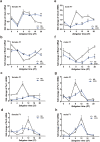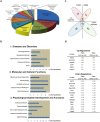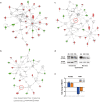Environmental perturbation of the circadian clock during pregnancy leads to transgenerational mood disorder-like behaviors in mice
- PMID: 28974783
- PMCID: PMC5626699
- DOI: 10.1038/s41598-017-13067-y
Environmental perturbation of the circadian clock during pregnancy leads to transgenerational mood disorder-like behaviors in mice
Abstract
It remains unknown whether chronic circadian disturbance (CCD) during pregnancy can lead to mood disorders in the offspring. Here we show that pregnant mice in the F0 generation that were exposed to CCD stress displayed depression-like behaviors, and produced offspring in the F1 and F2 generations that also exhibited mood-associated behavioral phenotypes despite the lack of direct stressful experiences during their postnatal or adult period. Prenatal CCD stress was correlated with the elevation of plasma corticosterone levels in F1 mice. Furthermore, the diurnal expression profiles of core circadian clock genes were disrupted in the suprachiasmatic nucleus of F1 mice. Proteomics analysis revealed that prenatal CCD stress resulted in distinct changes in protein expression in the hypothalamus of female F1 mice, in particular proteins that were associated with cellular activities, metabolism, development and diseases. Sex-specific differences in melanocortin 4 receptor expression were apparent in the CCD F1 generation. We conclude that maternal exposure to chronic circadian disturbance during pregnancy can lead to sex-specific mood disorders that persist for at least two filial generations. The underlying mechanisms may depend on transgenerational changes in plasma corticosterone levels, circadian pacemaking, and hypothalamic protein expression.
Conflict of interest statement
The authors declare that they have no competing interests.
Figures






Similar articles
-
Paternal environmental enrichment transgenerationally alters affective behavioral and neuroendocrine phenotypes.Psychoneuroendocrinology. 2017 Mar;77:225-235. doi: 10.1016/j.psyneuen.2016.11.013. Epub 2017 Jan 4. Psychoneuroendocrinology. 2017. PMID: 28104556
-
Rhythm and mood: relationships between the circadian clock and mood-related behavior.Behav Neurosci. 2014 Jun;128(3):326-43. doi: 10.1037/a0035883. Epub 2014 Mar 24. Behav Neurosci. 2014. PMID: 24660658 Review.
-
Enhanced endocrine response to novel environment stress and lack of corticosterone circadian rhythm in staggerer (Rora sg/sg) mutant mice.J Neurosci Res. 2006 Jun;83(8):1525-32. doi: 10.1002/jnr.20843. J Neurosci Res. 2006. PMID: 16555296
-
Prereproductive stress in adolescent female rats affects behavior and corticosterone levels in second-generation offspring.Psychoneuroendocrinology. 2015 Aug;58:120-9. doi: 10.1016/j.psyneuen.2015.04.013. Epub 2015 Apr 24. Psychoneuroendocrinology. 2015. PMID: 25973567
-
[Transgenerational effects of prenatal stress of different etiology].Izv Akad Nauk Ser Biol. 2012 Sep-Oct;(5):529-39. Izv Akad Nauk Ser Biol. 2012. PMID: 23136741 Review. Russian.
Cited by
-
Feto-Maternal Crosstalk in the Development of the Circadian Clock System.Front Neurosci. 2021 Jan 12;14:631687. doi: 10.3389/fnins.2020.631687. eCollection 2020. Front Neurosci. 2021. PMID: 33510617 Free PMC article. Review.
-
Circadian disruption during fetal development promotes pathological cardiac remodeling in male mice.iScience. 2024 Jan 26;27(2):109008. doi: 10.1016/j.isci.2024.109008. eCollection 2024 Feb 16. iScience. 2024. PMID: 38352228 Free PMC article.
-
Sox2 Ablation in the Suprachiasmatic Nucleus Perturbs Anxiety- and Depressive-like Behaviors.Neurol Int. 2021 Oct 26;13(4):541-554. doi: 10.3390/neurolint13040054. Neurol Int. 2021. PMID: 34842772 Free PMC article.
-
Effect of gestational exposure to dim light at night on the behavior of rat dams and offspring.Sci Rep. 2025 Jul 28;15(1):27373. doi: 10.1038/s41598-025-12322-x. Sci Rep. 2025. PMID: 40721724 Free PMC article.
-
Circadian rhythms as modulators of brain health during development and throughout aging.Front Neural Circuits. 2023 Jan 19;16:1059229. doi: 10.3389/fncir.2022.1059229. eCollection 2022. Front Neural Circuits. 2023. PMID: 36741032 Free PMC article. Review.
References
Publication types
MeSH terms
Substances
Grants and funding
LinkOut - more resources
Full Text Sources
Other Literature Sources
Medical
Miscellaneous

